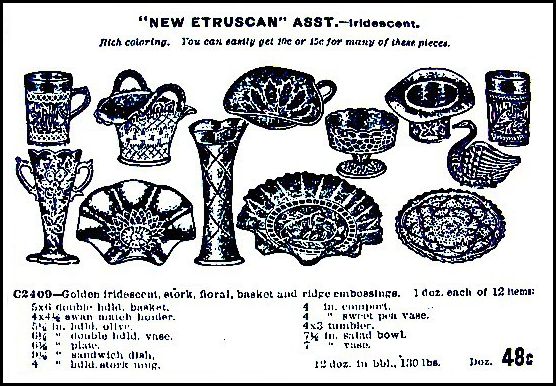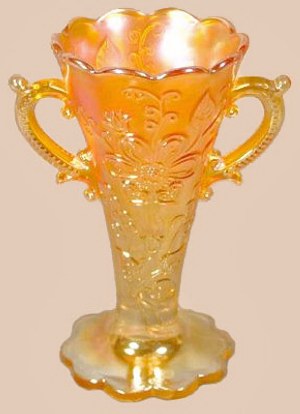Carnival Glass 101 | home Quick Reference to Carnival Glass Patterns on This Site
Diamond Glass - Part 2
Diamond Glass - Part 2

April 1915 Butler Ad
MARY ANN: This vase does not appear in any of the known wholesale catalogs until 1915, placing it into the Diamond era of production.
Two carnival versions of the vase are known. This two handled type is seen more often. It has eight scallops on the top edge and rests on a pedestal foot. Only marigold and amethyst are known, with marigold seen more often. Few amethyst examples surface. A few marigold vases turn up having ten scallops along the top edge. Occasionally, a blue opalescent non-iridized two-handled version is found.
It is the three-handled vase in this pattern which stirs buyers with enthusiasm. It is called a Loving Cup and has been reported only in marigold. It is much more rare than its two-handled counterpart. The original factory mold drawing for the Mary Ann vase was discovered at the site of the former Diamond Glass Company, ten years after the destructive 1931 fire.
NOTE: The two-handled vase has been reproduced in iridized pastel blue and appears for sale over eBay quite frequently.
 |
 |
BAND Hatshape -
|
BAND Hatshape -
8.50 in. to top of handle.
|
 |
 |
Marigold BAND Hat
marketed in a different metal basket.
|
BAND Clear Handled Basket -
Marigold.
|
BAND: The hat shapes are seen fairly often, usually having two sides pinched in. Some were purchased by makers of the metal holders, in order to promote sales in both cases. This “marriage” of containers occurred frequently during the mid-teens on into the 1930s. (Anything for a sale!)
Amethyst and marigold are the colors. Few and far between, the clear handled marigold baskets are treasures. (To view an amethyst handled basket in Band pattern, please click on ~~  ~~ in our pattern alphabet on the homepage! This one has hand lettering.)
~~ in our pattern alphabet on the homepage! This one has hand lettering.)
 |
 |
WINDFLOWER 9 in. Bowl in
|
WINDFLOWER 9 in. Bowl in
Cobalt Blue.
|
 |
 |
WINDFLOWER Nappy in Amethyst
|
WINDFLOWER Nappy in Lavender -
7.5 in. across x 3.5 in. high.
|
WINDFLOWER: The original factory mould drawing was discovered at the Indiana, PA site ten years after the 1931 fire which closed the plant. The design debuted in the spring of 1915, as part of the Etruscan iridescent novelty assortment shown in Butler Brothers wholesale catalog. Since the handled nappy is known in ice green, we know that production extended into 1921 when Diamond introduced its iridescent pastel green line. Considering its extended popularity, it is no wonder so many examples remain available today.
Three shapes are known. The 7 ½”-9” collar-based bowls are plentiful in marigold. Amethyst examples may be somewhat more challenging, with cobalt blue examples more difficult to find. Most bowls are ruffled, with just a few ice cream shaped examples.
8”-9” flat plates are not easily obtained, with amethyst more difficult than marigold. Cobalt blue flat plates should be considered rare.
The large, single-handled-nappy, usually spade-shaped, are available in a wider range of color: marigold, amethyst, cobalt blue, lavender, ice green and peach opalescent. Cobalt blue should be considered rare. A choice few ice green nappies are known, and rarest of all are the peach opal examples. (To view an ice green nappy, please click on ~~  ~~ in our homepage pattern alphabet).
~~ in our homepage pattern alphabet).
Dean & Diane Fry -- 08/08


“BLESSED IS THE MAN WHO ENDURES TEMPTATION”…….(James 121:12)
James, a bondservant of God and of the Lord Jesus Christ,
To the twelve tribes which are scattered abroad:
GREETINGS,
My brethren, count it all joy when you fall into various trials, knowing that the testing of your faith produces patience.
But let patience have its perfect work, that you may be perfect and complete, lacking nothing.
If any of you lacks wisdom, let him ask of God, who gives to all liberally and without reproach, and it will be given to him.
But let him ask in faith, with no doubting, for he who doubts is like a wave of the sea driven and tossed by the wind.
For let not that man suppose that he will receive anything from the Lord; he is a double-minded man, unstable in all his ways.
Let the lowly brother glory in his exaltation, but the rich in his humiliation, because as a flower of the field he will pass away.
For no sooner has the sun risen with a burning heat than it withers the grass; its flower falls, and its beautiful appearance perishes.
So the rich man also will fade away in his pursuits. Blessed is the man who endures temptation;
for when he has been approved, he will receive the crown of life which the Lord has promised to those who love Him.
Let no one say when he is tempted, “I am tempted by God”; for God cannot be tempted by evil, nor does He Himself tempt anyone. ~~~ James 1:1-13
|


Should you care to contact the Frys, their email address is:
Search Carnival Glass 101
back to Carnival Glass 101
Our other sites you may enjoy:
Everything you EVER wanted to know about Indiana Glass
Great Reference for Newer Carnival Glass.
Complete Glassware Catalogs Available to Download
Questions? Comments? Suggestions? Broken Links? Corrections?
Your Friendly Webmaster is here to help!



